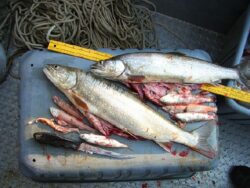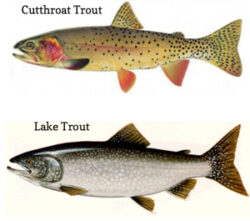Yellowstone Lake is now home to another invasive species. Ciscoes, a large and popular baitfish, were discovered in the gill nets used to remove lake trout. The 3-year-old Cisco was examined closely. The Otolith, an internal bone, was closely scrutinized and proves that the Cisco was born in the lake. This means that there is a reproducing population of these baitfish in the lake. 
Ciscoes are not native to Montana. The closest reproducing no-native Cisco population is in Fort Peck Reservoir, 250 miles away. Obviously, Ciscoes did not swim into the lake. Birds did not carry them there. The most likely scenario is that Lake Trout fishermen used bait buckets, with aerated temperature-controlled gear to transport this baitfish into the 85,000-acre Yellowstone Lake.
Yellowstone Lake is home to native Yellowstone Cutthroat trout. This once amazing fishery was the home of a hatchery that sent eggs across the world and supported a huge commercial fishery. Today, the Cuttie population is improving, but still threatened by invasive Lake Trout, which were also planted into the lake by Bucket Biologists. Scientists documented their presence in 1994. Lake trout eat the less aggressive and smaller cutthroats. It appears that the Lakers had been in the lake for decades. When the population finally grew, the Yellowstone Cut population was torn apart.
It has taken millions of dollars and decades of gill netting to just start to save the Yellowstone Cuts. These amazing, unique trout are essential to the Park’s special ecosystem. The lake is one of their last bastions of existence.
There are groups of anglers that are opposed to the removal of wild born mackinaw trout. They appear to be actively and illegally, promoting Lake Trout and their favorite forage bait. This means the illegal transport and stocking of nonnative species. The same selfish behavior has been connected to stoking of walleyes, pike, and other species. Transporting fish, hundreds of miles, takes time and intentional technology.
No matter how the Lake trout or ciscoes ended up in Yellowstone Lake, they are there to stay. Annual gillnetting and other means of eradication can lower the invasive populations but once this ends, it will be just a matter of time until the invasive species return. Whether the Yellowstone Cutthroats find a way to compete and survive is yet to be seen. Maybe the ciscoes will become a targeted food for cutties. Maybe the Lake Trout will be finally removed by some new technology or poison.
Hopefully Nature will find a way to fix what humans have screwed up.
Montana Grant